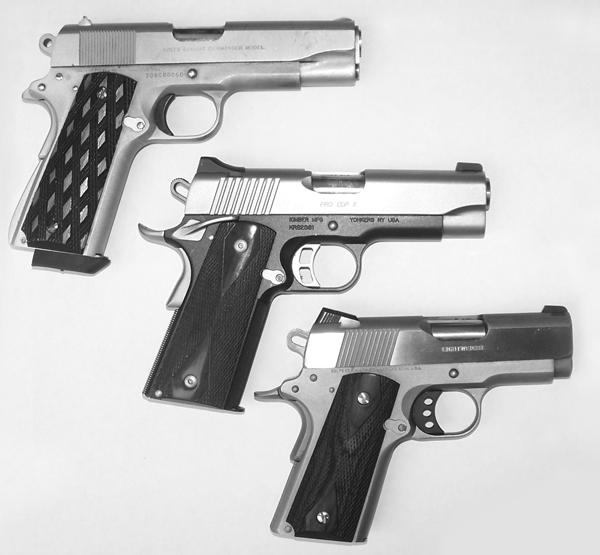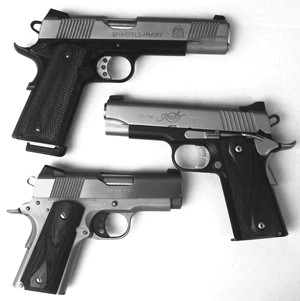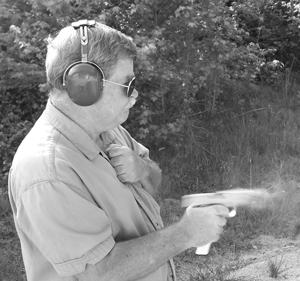

If there is a legitimate criticism of the 1911 as a carry gun, it is size and weight. But the 1911 is also available in smaller size configurations known as the Commanders, Defenders and Officers Model 1911s. Choosing from among these models you'll be sure to find a pistol to match your needs.
If there is a legitimate criticism of the 1911 as a carry gun, it is size and weight. The pistol is thin but long and heavy. Do not let anyone convince you the 1911 is dated. It is simply from another era in which handguns were designed to save your life and were not based on liability concerns. The pistol is designed to be as fast as a good boxer, with a well timed and devastating blow foremost.
The Colt Commander is the result of a desire for a lighter and handier 1911. While the story goes the Commander was designed to offer the military a downsized pistol, there had been prototypes of a short .45 kicking around Hartford before World War II.
The use of aircraft grade aluminum for the frame allowed a very light and handy concealment piece. The Commander retains the full size grip of the Government Model. This allows comfortable firing and a good sharp draw. Size has much to do with confidence and control. Although it is appreciably lighter than the Government Model, the Commander is a controllable handgun – with practice.

With the Series 70 production run the Combat Commander Colt was introduced. This is simply a steel frame Commander. The Combat Commander is now known as simply the Commander while the aluminum frame Commander is the LW Commander. The steel frame Commander offers excellent balance. The problem with reducing the length of the pistol as far as reliability was the higher slide velocity, which was addressed by spring technology.
But then we also had a shorter spring that had to exert more pressure. The shortened slide length reduces the total reciprocating mass but also alters the way the magazine presents the round to the breech face. In the end, it was a wonder the Commander was so reliable. It’s a great pistol.
The Officer’s Model was the original short 1911, with a 3.5-inch barrel and grip shortened enough to cut magazine capacity by one round. Today most compact pistols have 3-inch barrels. The Officer’s Model demanded considerable revision of the design but the 3-inch pistols even more so. In order to accommodate the sharper barrel tilt in a short slide pistol, the barrel no longer used a barrel bushing. The Commander used a standard bushing, although it was shortened.
The Defender features a belled barrel that contacts the slide directly. One of the standard 1911 locking lugs was removed in order to allow the barrel to recoil proportionately more to the rear of the pistol. These design changes were essential in order to produce a functioning short slide handgun.
The 3-inch idiom has proven very popular. The Officer’s Model is now out of production and seems unlikely to return. These three idioms – the Government Model, the Commander and the Officer’s Model – were once the defining descriptor of 1911 frame and slide sizes. Today Government Model, Commander and Defender are more apt descriptions of the increasingly popular compact and ultra-compact descriptions.
A new and very popular handgun is the 4-inch barrel 1911. Some of the best of the modern 1911s are 4-inch guns. These include the Kimber Pro Carry, the Kimber CDP, the Para TAC FOUR and the Springfield Champion. The 4-inch barrel 1911s are more in line in size and weight with the popular service pistols from other makers such as the SIG P226 or Glock Model 23. They are superior service pistols and take much drag off of the uniform belt. They are also ideal concealed carry pistols.
They are available in both aluminum frame and steel frame versions in weight ranging from about 26 to 33 ounces. These pistols feature the belled barrel type lockup as they are too short to utilize a barrel bushing properly. In my experience these are very reliable handguns. They clear leather quickly, get on target quickly, and offer excellent hit potential. They also rate high on the smile test, with most raters reacting favorably to the handling and accuracy potential of these handguns.

A LW frame 1911 is not for non-dedicated personnel. The pistol demands attention to detail and proper technique to master. I find the lightweight 4-inch barrel 1911 easier to control than a polymer frame .40 caliber pistol, but there is time and effort in the equation. The difference is that you will be able to reach a high level of competence with the 1911 that may elude shooters using the polymer frame pistols. The 4-inch pistol certainly falls into the ‘if I could have only one pistol’ category. It is that versatile.
At this point you may reasonably ask for a recommendation on which 1911 is best for you. My recommendation is always to begin with a steel frame 5-inch barrel Government Model. I might add that it is best to purchase the best quality handgun you can afford for a good return on performance and future trade-in.
If you are beginning with a concealment pistol, then the steel frame Commander is an excellent first choice. I simply do not recommend jumping into a lightweight frame 1911 without considerable experience with the Government Model. A good 4-inch barrel steel frame pistol may be concealed, and with proper selection of a good holster such as the inside the waistband holster illustrated from Milt Sparks, then you will have a good comfortable platform for carrying the pistol.
There is more weight but as you begin your shooting career you will appreciate it.
Moving to the lightweight 3-inch barrel pistols such as the Colt Defender is a gradual process. As an example, I began my 1911 journey with the Combat Commander. It was some time before I considered the smaller pistols, and I found many of them not as reliable as the Government Model. Times have changed. The Colt Defender and the compact Kimber pistols are another story. These handguns demand attention to detail but they are reliable, accurate enough for personal defense, and good examples of the gunmaker’s art.

They are not as useful for all around informal target practice and competition shooting but that is not their design goal. These are first class lightweight personal defense handguns. When you consider the snub nose .38s and double action only 9mm pistols in wide use, the Colt Defender as an example is a wonderful defensive handgun in trained hands.
The short sight radius of the Defender and the Kimber compact pistols may challenge marksmanship. A slight misalignment of the front sight is less noticeable when the sight radius is shorter than average. I recommend that any compact defensive handgun have good sights. Superior sights are an aid in hit probability, perhaps more important in the case of the compacts that with the full size handguns. Fit, feel and a long sight radius may be compromised in the compact pistols, but, just the same, these are first class defensive handguns.
Despite their short grips and short sight radius, the position of their controls is all 1911, and that means very ergonomic. Increased recoil is far from startling if you have began your shooting career on the Government Model. These handguns are a technical accomplishment well worth your praise and attention.
This article is an excerpt from the book Gun Digest Shooter's Guide to the 1911.

Next Step: Get your FREE Printable Target Pack
Enhance your shooting precision with our 62 MOA Targets, perfect for rifles and handguns. Crafted in collaboration with Storm Tactical for accuracy and versatility.
Subscribe to the Gun Digest email newsletter and get your downloadable target pack sent straight to your inbox. Stay updated with the latest firearms info in the industry.









Warning: since I was a teen, the M1911 has fit my hand like a glove, for me it’s ergonomically perfect so I may be a special case.
I wonder if the author is overstating the issues with switching between a somewhat “lightweight” model and a normal one. I own both a 100% steel (aside from the mainspring block) 5 inch model plus a Kimber Pro Carry (first generation), which is an aluminum frame 4 inch model. I notice *some* difference when I fire them, but it’s not marked, doesn’t require adaptation and doesn’t seem to make much difference in accuracy (then again I’m not shooting bulls-eyes).
I agree that a standard 5 inch steel model ideally would be the base of your M1911 collection (it’s what I have for home defense) but don’t be too afraid to try one of the smaller models and see how it preforms in your hands. I can say the Pro Carry is nearly a joy to carry (still weights a bit much), and as usual the thinness of the M1911 makes it conceal pretty well. I also would not be upset if the Pro Carry was the only one I had; it or an equally high quality model with the same features should be able to earn your complete confidence.
Very good article, although I can not say I totally agree with some of the thoughts about short barreled 1911’s. I began my 45 1911 experience, shooting with the Kimber SIS Ultra. Awesome piece of work; very accurate and easy to handle; helped by it’s heavyweight. I have shot a lot of different handguns (pistols and revolvers), still find this to be one of my favorites. Everything about it just feels good. I am hoping to check out a Kimber Super Carry HD in PRO 4″ size one day. I also have a Springfield TRP Full Size 5″; it is an equally fine piece, though I still like the SIS better. I’ve also looked at the new S&W 1911’s; might have to test ride one of these in the future, sure do feel nice in the hand. I noticed you didn’t mention 3.5″ barrel 1911’s. They are also another nice alternative if you want a carry conceal 1911. I have a Rock Island 3.5″. For a relatively inexpensive (less than 5 bills) 1911, it is a well made reliable piece.
Nitpicking, I know, but “idiom” or iteration?
I realize there are a ton of 1911’s out there but you should mention the Sig line of 1911’s. The quality is the best.